What Happens When 800 Editors Assemble for 3 Days
When I told people I was going to Providence, Rhode Island, to attend ACES 2019, the annual conference of ACES: The Society for Editors, the most common response was some version of “What do you do there?” — often followed by lighthearted guesses at an answer:
- “Glue split infinitives back together?”
- “Decide which words we’re all going to overuse in the next year?”
- “Get out the measuring tape and see who has the longest dangling participle?”
As often as I was asked, my answer to that seemingly simple question never felt complete, and it wasn’t until I arrived at the conference last week and read through the schedule that I understood why. Editor is such a broad term, and growing ever broader as technology rushes on. Just as the title driver might take in school bus drivers, truckers, chauffeurs, and race car drivers, the title editor encompasses a wide and multifaceted world of wordsmithing. Which means a simple question like “what do editors talk about” isn’t so simple after all.
So what follows is just an overview of what goes on when more than 800 editors converge on a single city to talk shop for three days.
Every type of writing requires editing, and each type comes with its own nuances and expectations. You might think of them as genres of editing, but they aren’t quite like the fiction genres the word might bring to mind. For example, there were sessions on editing recipes, marketing copy, romance fiction, translations, legal documents, and children’s books, and even a session — hosted by two government editors, one working for the CIA and one for the FBI — called “Copy Editing in the Government During a Crisis.”
And there’s more to a career in editing than just, well, editing. As print magazines are closing up shop and newspapers are laying off their editorial staffs in record numbers, many editors find themselves on their own. Freelance editors are a huge and growing chunk of the more than 3,000 member of ACES, and so conference attendees had opportunities to learn about building an editorial business, hunting down clients, and getting paid, as well as a session on other career possibilities for someone with copy editing skills.
We also talked about our tools and how best to use them in sessions about fact-checking; tricks and hacks in Microsoft Word, Slack, and PerfectIt; social media; and, for those who love to swim in data, corpus linguistics. There was even a session on ergonomics that, as the soreness in my lower back grows, I now wish I had found the time to attend.
But underlying the multifarious nature of editing lies the lexical heart of the discipline. Editing is fundamentally about the words — choosing the best ones, eliminating the unnecessary ones, and giving text that shine that makes it worth reading. And there was plenty of talk about words.
A centerpiece of the ACES conference each year is the announcement by the editors of the Associated Press of upcoming changes to the AP Stylebook, the primary style and usage manual of journalists and a handy reference for many of us. This year’s updates include the following:
- We are now encouraged to use accent marks in the names of people who prefer them and when quoting from a language that uses them. (Technology has finally caught up.)
- Except in scientific and academic papers, the use of a singular verb with data (“This data is whack” instead of “These data are whack.”) is acceptable.
- We should avoid using the phrase racially charged as a euphemism for racist. (This announcement won some cheers.)
- We should avoid using the word casualties because of its ambiguity — it includes both deaths and injuries — and try to be as specific as possible.
- AP style now prefers use of the percent symbol rather than the word percent when paired with a numeral. (We aren’t strict adherents to AP style here at the Post, and we won’t be implementing this change anytime soon.)
New this year was an open discussion with Paula Froke and Colleen Newvine, respectively the AP Stylebook’s lead editor and product manager, about possible future changes to their guidance on numbers — specifically on whether a number should be written as numerals (3 mugwumps) or spelled out (three mugwumps). They are considering recommending that journalists use numerals in practically every situation, and the editors attending that session were pretty evenly split on the idea. (The Post won’t be doing this, either.)
There were also sessions on editing for readability; on being sensitive to racial, religious, and gender biases in language; on writing about death; on crafting good headlines; on etymology; on editing footnotes; and on when to use “bad English.” (There are literally a bajillion ways that breaking the “rules” of “good English” can transform text from boring to da bomb.)
And there was even a session about grammar. Go figure.
Does it seem like a lot to take in? Because it was a lot to take in. And because these sessions were run seven or eight at a time, sadly, I couldn’t take it all in.
That’s probably for the best, because the sessions I was able to attend could get pretty intense. (While freelance editor Heather Saunders’ presentation on vicarious trauma and editing distressing content was extremely valuable, it wasn’t the pleasantest way to start a Friday morning.) Not to worry, though; we editors also know how to have fun.
My conference experience began on Wednesday, March 27, the night before the official conference kickoff. I competed in the spelling bee, a fundraiser for the ACES scholarship fund. This isn’t everyone’s idea of fun, but I had a blast … at least until about six rounds in, when our pronouncer, Merriam-Webster’s editor at large Peter Sokolowski, announced that the next round would consist entirely of Scottish words. (Seriously. Harnpan? Bum-clock? Fliskmahoy? I went out on freity.)
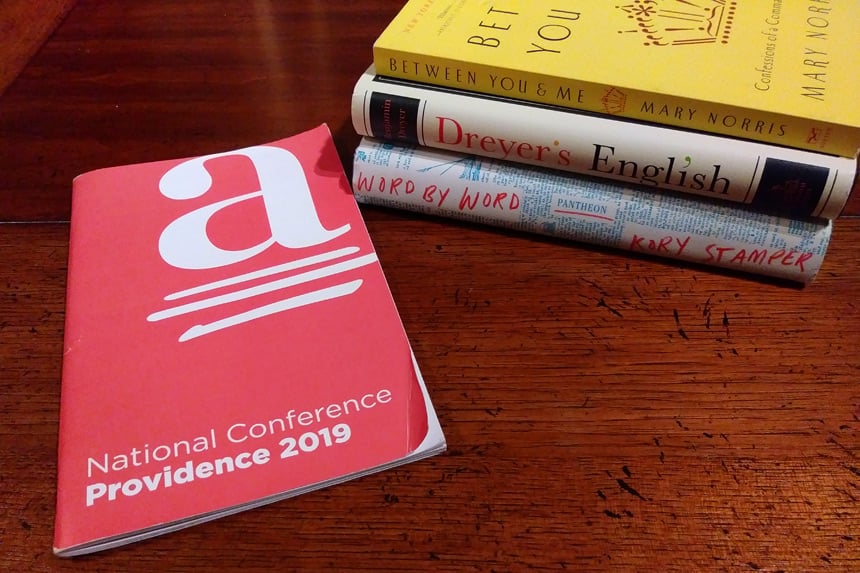 We also had Mary Norris and Benjamin Dreyer on hand to chat about their recent books Greek to Me and Dreyer’s English (and yes, I got autographs, as well as Kory Stamper’s in Word by Word). We had mixers and networking lunches, and we had a nice banquet. We had a silent auction fundraiser involving some of the word-nerdiest things you’ve ever seen. We had Bananagrams and we had Scrabble.
We also had Mary Norris and Benjamin Dreyer on hand to chat about their recent books Greek to Me and Dreyer’s English (and yes, I got autographs, as well as Kory Stamper’s in Word by Word). We had mixers and networking lunches, and we had a nice banquet. We had a silent auction fundraiser involving some of the word-nerdiest things you’ve ever seen. We had Bananagrams and we had Scrabble.
We had a good time.
Good editing is invisible, and a career in editing — not exactly a team sport — can be very isolating. For me, a gathering like ACES 2019 is not only an educational experience, it’s a rejuvenating one. It’s a chance for me to be among My People, as awkward and introverted as we generally are, to shine a spotlight on all the hard work we do that no one else ever sees, and to share our experiences so that we might grow both personally and professionally. It’s a chance to recharge.
It lasts only three days a year, but it’s the best three days.
Photos courtesy Andy Hollandbeck
Cover Gallery: Mid-Century Mothers and Sons
People talk about the special bond between mothers and sons, but some of these ‘40s and ‘50s moms don’t look so sure.
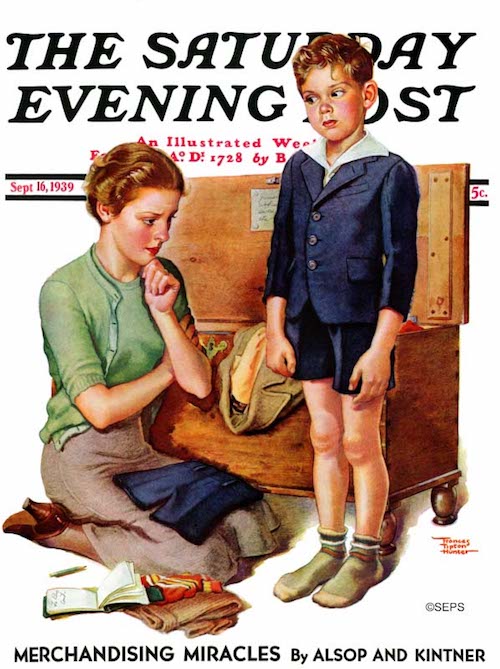
Frances Tipton Hunter
September 16, 1939
Any mother can relate to the problem of the growth spurt, as painted by Frances Tipton Hunter, who created 18 covers for The Saturday Evening Post. Hunter was particularly interested in drawing children and animals. She also illustrated a series of paper dolls in the 1920s for the Ladies’ Home Journal, which proved to be extremely popular.
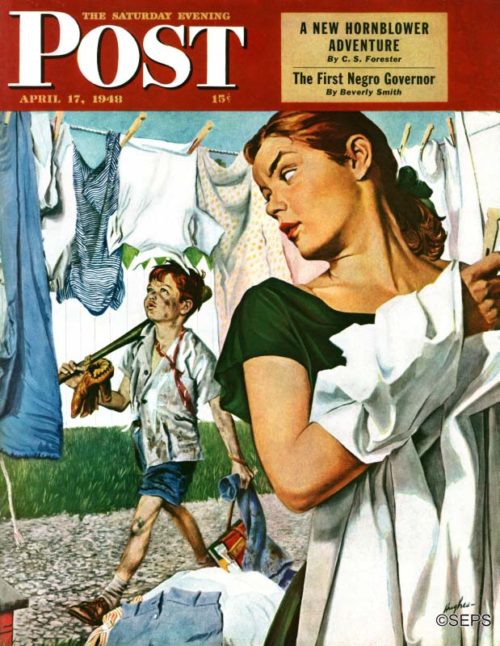
George Hughes
April 17, 1948
[From the editors of the April 17, 1948, issue of the Post] The old, old losing fight to keep a boy in clean clothes, when in five minutes he can get dirtier than a grease monkey, is noted here by an artist taking his first crack at a cover. He is George Hughes, one of the country’s best-known illustrators, whose work in that field is highly familiar to Post readers.
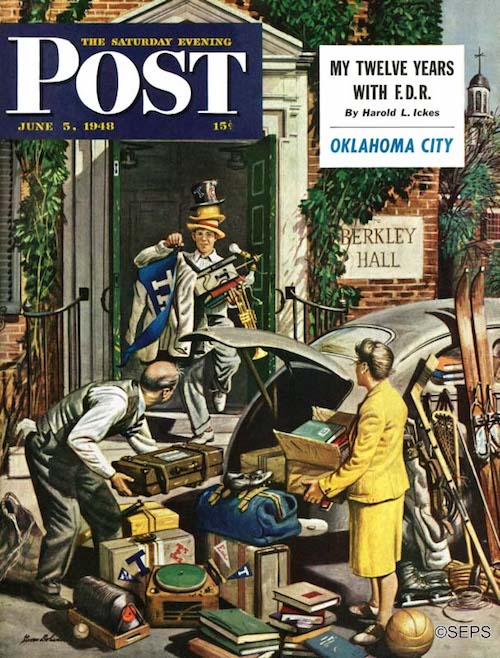
Stevan Dohanos
June 5, 1948
[From the editors of the June 5, 1948, issue of the Post] Stevan Dohanos’ two sons, Peter and Paul, were in an Eastern boys’ school and about this time last year, getting-out time, he took the family car up to help them move home. A passenger car, he learned, is no proper vehicle for such a job. It calls for a light truck or van. Brooding about this, and what it meant for the future, Dohanos mentioned his trip to a friend with a son or sons in college. They told him his real moving jobs are still ahead, when he tries to load the contents of one college room. The artist made his sketches on the Yale campus, but rearranged things to suit his purposes. The boy is George Ritter, of Westport, Connecticut, no Yale man. The artist didn’t use a Yale man, on the remarkable theory that none would like to cut class.
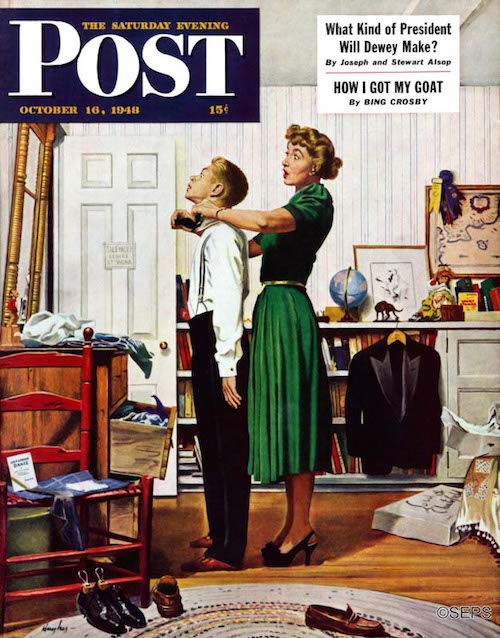
George Hughes
October 16, 1948
[From the editors of the October 16, 1948, issue of the Post] It’s that suspenseful occasion when a young man puts on his first tuxedo to go out to a formal party—or more commonly, first puts on his father’s tuxedo or one borrowed from an older brother. Looking around for models, it occurred to artist George Hughes that some of his neighbors would serve excellently. The boy getting ready to dazzle them at the dinner dance, if he doesn’t forget and wear moccasins, is Tommy Rockwell, son of artist Norman Rockwell. The woman essaying the puzzling job of tying somebody else’s tie is Tommy’s mother. That is Tommy’s room, in Arlington, Vermont, and Hughes was much impressed—he thought it remarkably tidy, as boys’ rooms go. Temporarily tidy, at least, and you can’t ask more than that.
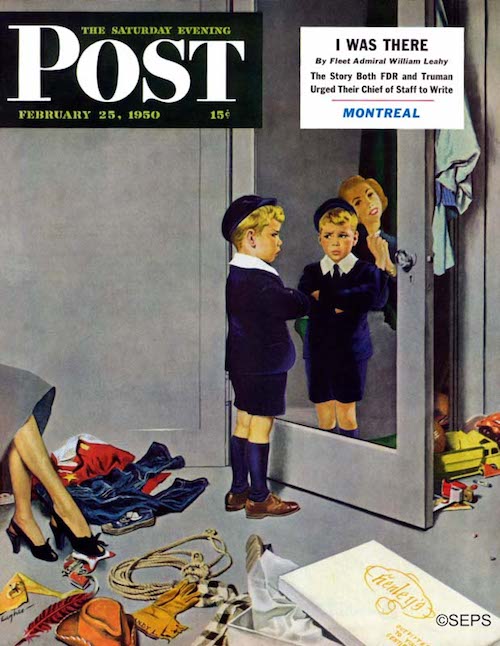
George Hughes
February 25, 1950
[From the editors of the February 25, 1950, issue of the Post] “Outfitters to Young Gentlemen,” proclaims the suit box, in a blundering effort to make the victim of its contents feel as swell as he looks. The young character does not wish to look like a young gentleman. What, he wonders in horror, will the gang down the street think when he bursts upon their gaze and is recognized as the guy they had always thought of as a normal, gun-toting cowboy? Will they clasp their hands as mother is doing, only with a less complimentary ecstasy? One ray of hope plays on the dark scene. In the next few weeks other misguided mothers will get this same new-suit fever, and on Easter Sunday many young cowpokes, in similar outrageous disguises, will be comforted by their companionship in misery.
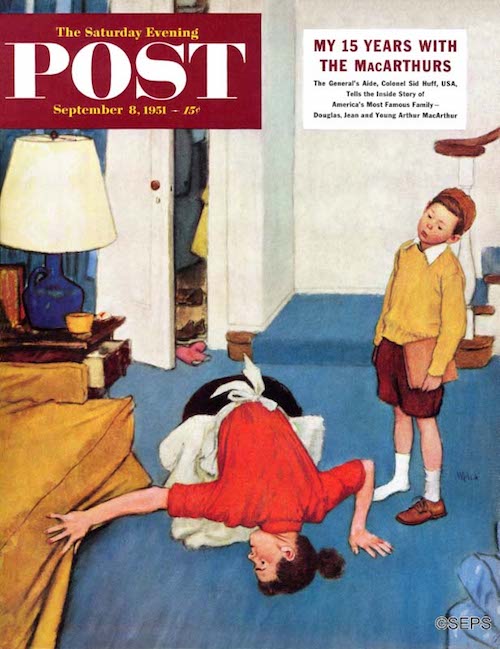
Jack Welch
September 8, 1951
[From the editors of the September 8, 1951, issue of the Post] This mother’s face is charming upside-down, but if you will also stand on your head, you will find that she wears a choleric expression. She is mad at her son, which is unreasonable, for she herself has lost his shoe. He took it off last June, and is it not a woman’s duty to take care of her men’s clothing? We know where the shoe is: it is either in the Apache hide-out under the forsythia bush, in the cowpoke’s corral in the vacant lot down the street, or Fido is preserving it in his kennel as an objet d’art. Junior will go to school in sneakers, and nobody will care except his mother, who doesn’t go to school. Next week she very likely will think all this is funny, and what the moral of Jack Welch’s theme is, we don’t know.
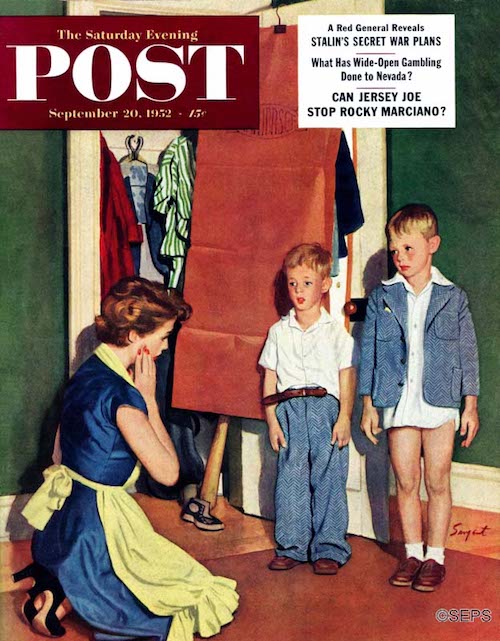
Richard Sargent
September 20, 1952
[From the editors of the September 20, 1952, issue of the Post] Inventors are so smart at dreaming up new types of cloth, why doesn’t some bright fellow concoct a rubber-base fabric, so that the suit of an expanding boy can occasionally be put on a stretcher and thus increase in pace with its master? When this idea goes into production, we get a 10 per cent cut or somebody gets sued. Meanwhile, Dick Sargent’s distraught homemaker can take a few gussets in that stationary suit and hang it on Son #2, but then the boy will promptly outgrow it. Oh, for the deflated old days when it wasn’t necessary to stop eating for a while to finance a new suit or stop buying suits to eat. Well, better times ahead, mother! Soon the lads will be big enough to hand down their clothes to their father.
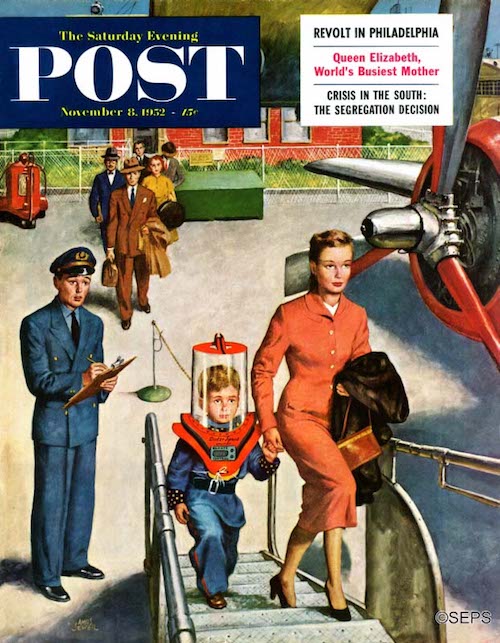
Amos Sewell
November 8, 1952
[From the editors of the November 8, 1952, issue of the Post] Little Johnny Tomorrow has just walked past young Mr. Today, making the latter look aged and out of date. It reminds us of a sad occasion when an airliner captain asked a little passenger if this was his first time up. “Fourteenth,” said the lad. ‘Can’t ever get up higher ‘n five, ten thousand feet in these old planes, though. How’s the United States ever going to build a space platform if you fellas can’t make altitude?” The captain, epitome of modernism, turned green and crept away to rev up his creaky old engines; and the boy should have been spanked for insolence, except that actually he had his feet on the ground. When artist Sewell’s youngster gets tired of wearing that helmet, the hostess could put it on somebody who is snoring.
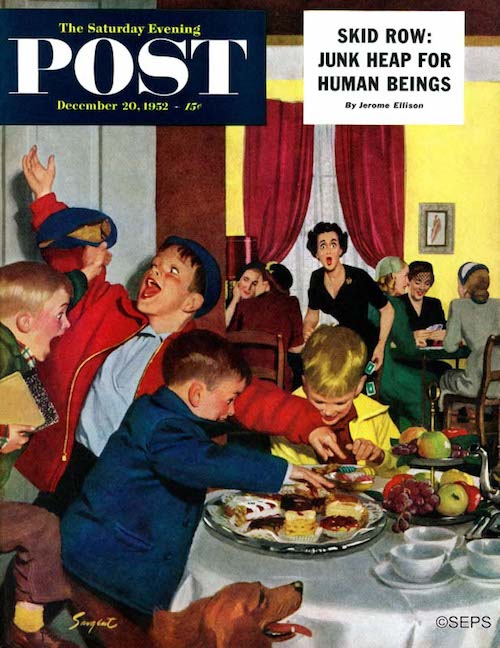
Richard Sargent
December 20, 1952
[From the editors of the December 20, 1952, issue of the Post] What is lovelier than the glow of care-free joy in the faces of happy children? Will the lady on the cover have the time to defend her food and change those expressions to the pinched melancholy of starvation? She will if she can make it across the room in time. It will be fairly cruel if she imprisons the lads in the kitchen with nice, healthy, disillusioning peanut-butter sandwiches, but not as cruel as the time Dick Sargent set up that enchanting pastry in his dining room to paint. He has sons. The mouths of the sons began to water. They watered for a week. Two weeks. Three. Then the sons were released at the pastry. They ate it so fast they apparently did not notice it was petrified, claims the fiendish father.
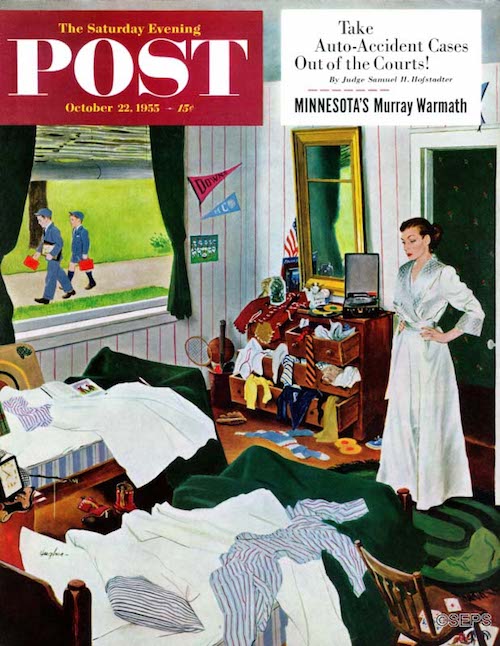
George Hughes
October 22, 1955
[From the editors of the October 22, 1955, issue of the Post] Mother is making rapid progress at teaching the boys to maintain a tidy room; if George Hughes had painted this the day school opened, the detail would have given him a lame arm. Now, here is portrayed an intelligent female who in her delicate way molds the character of men; so, when her boys are seniors in college, they will be 27 per cent tidier than now. Then they will get married and never leave so much as a pipe cleaner lying about—for six weeks. After that they will revert to human beings, and what they don’t chuck around will be what they haven’t got. A woman’s picking-up-stuff is never done. Why doesn’t this mother shock the boys into tidy conduct by simply leaving their shambles untouched? Because they like it this way. She’d better go buy herself a new hat.
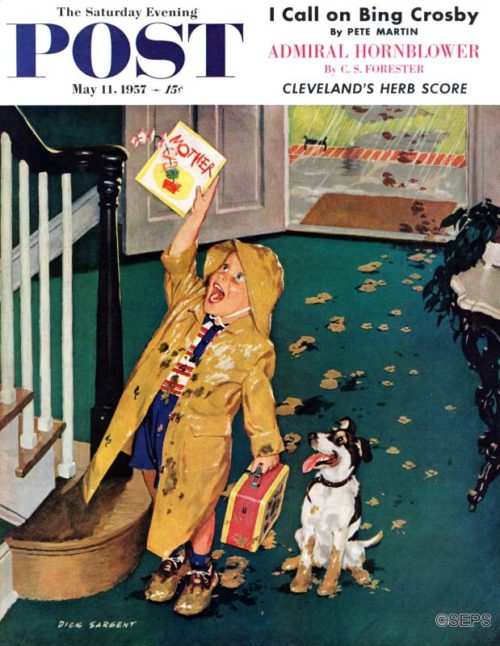
Richard Sargent
May 11, 1957
[From the editors of the May 11, 1957, issue of the Post] Johnny’s happy shout of “Mother, I’ve brought something for you!” is an understatement. Dick Sargent certainly can paint the most delicious-looking mud; did he use maple fudge for a model? Now then, when mother regards her ex-clean carpet and the adoration in the eyes of her seldom-so-soiled son, what type of emotion will possess her? Although a mother’s ups and downs often come simultaneously, and situations like this are all in the day’s work and love, the temperature of her reaction will depend partly on whether she’s a phlegmatic soul or pop-offy soul. Yet it’s a good bet that before she undertakes to make things come clean, she will administer to her son, fudge and all, a good, sound—kissing. Afterthought: if Fido decides to shake himself, all bets are off.
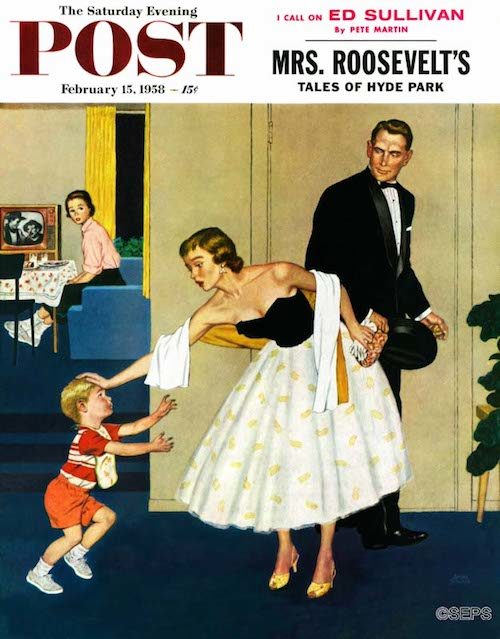
Amos Sewell
February 15, 1958
[From the editors of the February 15, 1958, issue of the Post] It’s typical of the male sex that Johnny is realizing how much his favorite lady means to him only when she is about to go away—and that’s enough psychology for this week. So John wants to cling to her, which will overlay a stunning new chocolate pattern on her dress, a chic addition to what seems to be a golden-fingerprint motif already put there by designer Amos Sewell. Without meaning to be unreasonable about this, is Miss Sitter going to come to the rescue or wait until the television program ends? Johnny’s situation is a bit pathetic as mamma delivers what football fans will recognize as a beautiful straight-arm; yet he does have loving parents, a swell home, luscious food, brisk entertainment and a pretty girl to dine with—what more can a young fellow ask?
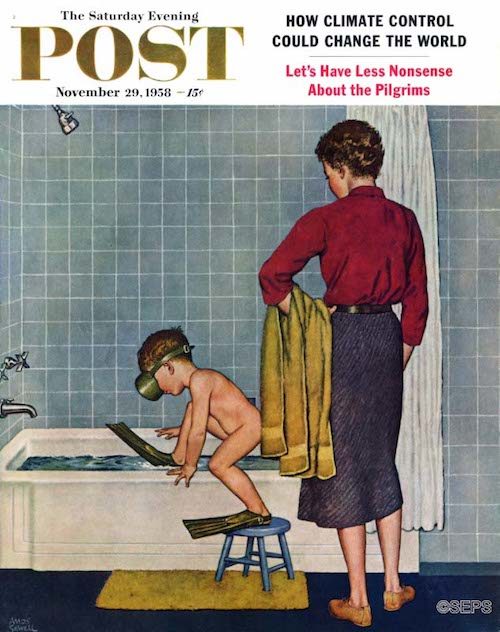
Amos Sewell
November 29, 1958
[From the editors of the November 29, 1958, issue of the Post] It looks as if artist Amos Sewell’s cover urchin is entering a bathtub of his own free will, and is therefore outwitting himself. Johnny’s decision to try out his diving gear has made him forget to remember that using water for the purpose of getting clean is bitterly repugnant to him. Mother could remind him of this, but why burden his little mind with confusing thoughts? So down Johnny will dive into the mysterious depths, seeking treasure on the floor of the sea, and down there he may well find a bar of soap. Then if mother and son excitedly agree that Johnny has found a rare specimen of submarine life worth maybe a trillion dollars or more, they will be sharing just a little white lie from which, as mother makes with the soap, great good will come.
Cover Gallery: Rainy Days
The weather may be dreary, but these rainy day covers will make you feel cheery!
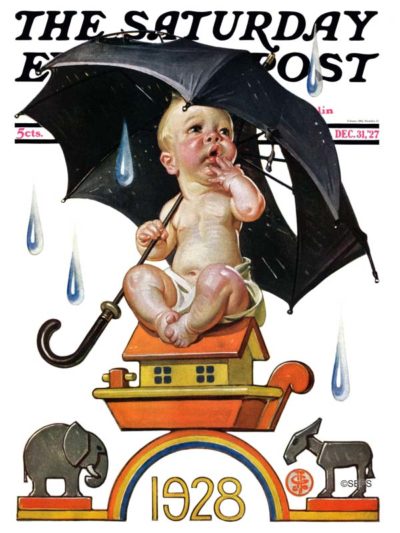
December 31, 1927
J. C. Leyendecker
Artist J. C. Leyendecker was well known for his Baby New Year illustrations that graced many Post covers from the 1910s through the 1940s. Our 1928 baby awaits the possible repeal of Prohibition, symbolized by “wet” weather.
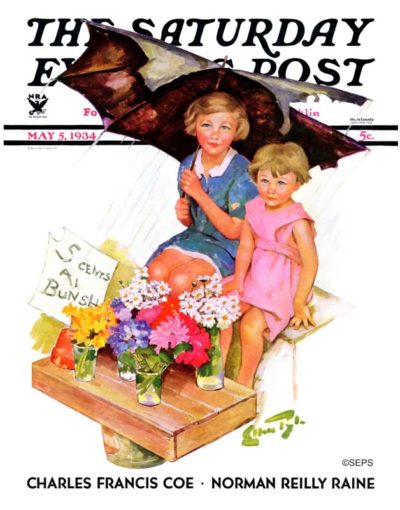
Ellen Pyle
May 4, 1934
The subjects in this illustration were likely artist Ellen Pyle’s own children; they served as the models in more than 20 of her Post covers.
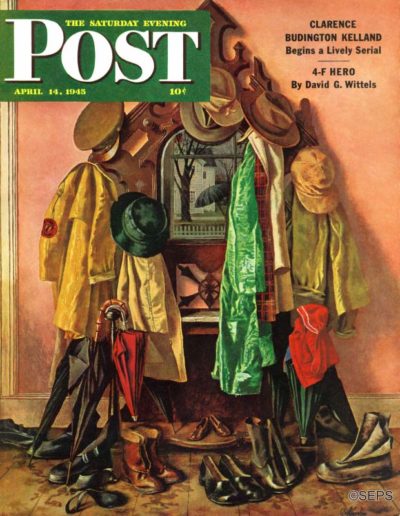
John Atherton
April 14th, 1945
[From the editors of the April 14, 1945 issue] Norman Rockwell suggested the idea to Atherton. The hatrack is in the hall of the Community House at Arlington, Vermont. Neighbors contributed the hats, coats and galoshes seen in the painting.
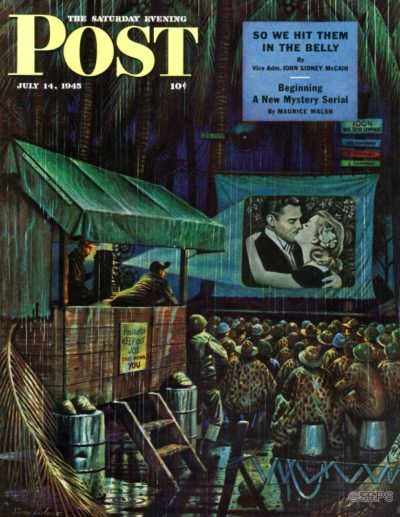
Stevan Dohanos
July 17, 1945
[From the editors of the July 17, 1945 issue] We imagine it is hard for anyone who has never sat on a Pacific spit kit of an island for months on end, contemplating the shapely curves of a can of tinned-pork products for emotional release, to understand Stevan Dohanos’ cover. After such soul-gnawing, a flickering, one-dimensional pin-up girl enlarged many times on an improvised screen must have the pulling power a naked electric-light bulb has for a moth. Most South Pacific movies are now first-run, sometimes world premieres; but when “Wilson” was shown on Okinawa before an audience just back from the front lines, there were eight air-raid interruptions, and the show assumed a three-and-a-half-hour Gone With the Wind proportion. Perhaps the reason why Dohanos’ G.I.’s are willing to sit in the rain is that their bucket seats are really magic carpets taking them home to Main Street for an hour or two.
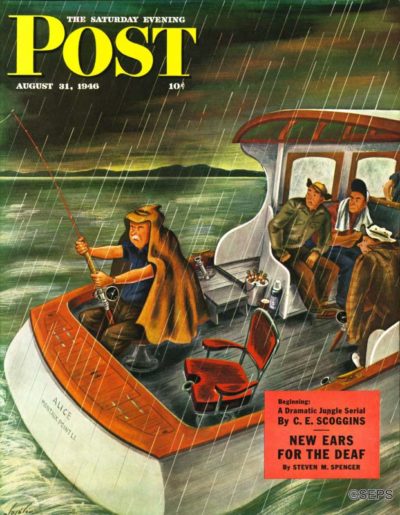
Constantin Alajalov
August 31, 1946
[From the editors of the August 31, 1946 issue] The man who has determined to go fishing, Constantin Alajalov observed when he was in Florida, will go fishing until he catches a fish, in spite of bad weather. Alajalov determined to paint this truth. There were a few things on which he needed to refresh his recollection, but to do this, he needed only to go out in a boat on a similar day. We don’t know how long the average determined fisherman has to wait for a sunny day. We do know how long Alajalov had to wait to catch a rainy one. One fair day followed another. He waited three weeks.
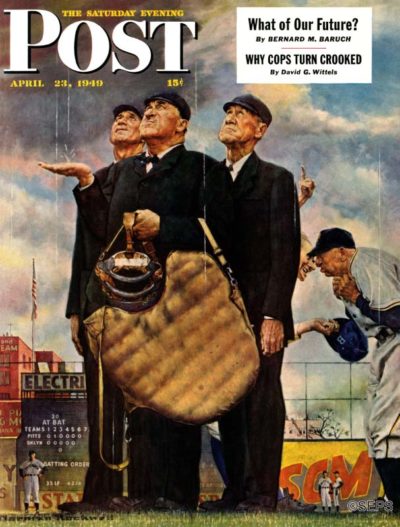
Norman Rockwell
April 23, 1949
[From the editors of the April 23, 1949 issue] This week’s Norman Rockwell cover depicts Ebbets Field, the home of the Brooklyn Dodgers. Here, the Dodgers are trailing the Pittsburgh Pirates 1-0 in the sixth inning. If the arbiters—left to right, Harry Goetz, Beans Reardon and Lou Jorda—call the game because of rain, the score will stand as is, and Pittsburgh will win. This irks the Brooklynites, who dislike having other teams win. In the picture, Clyde Sukeforth, a Brooklyn coach, could well be saying, “You may be all wet, but it ain’t raining a drop!” The huddled
Pittsburgher—Bill Meyer, Pirate manager—is doubtless retorting, “For the love of Abner Doubleday, how can we play ball in this cloudburst?”
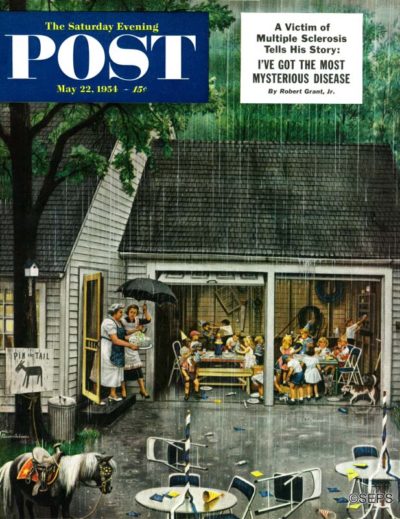
Stevan Dohanos
May 22, 1954
[From the editors of the May 22, 1954 issue] Rather than be depressed by Mr. Dohanos’ soggy scene, note how the deluge has improved the situation. Any birthday party is fun, even if nothing more happens than the duly expected games, grub and slight fights between incompatible little boys. But to arrange for the routine confusion to be stepped up into the joyous chaos of a garden party dispersed by a cloudburst, that’s a charming innovation indeed. And how delightful it is to throw a party in or into a garage, where tools and other weapons are available for favors as well as paper hats, where joy can he so much more unconfined than in an ordinary living-room hullabaloo. Even that pony thinks, Bless the rain—no more work. Fortunately, there isn’t space here for what mother thinks.
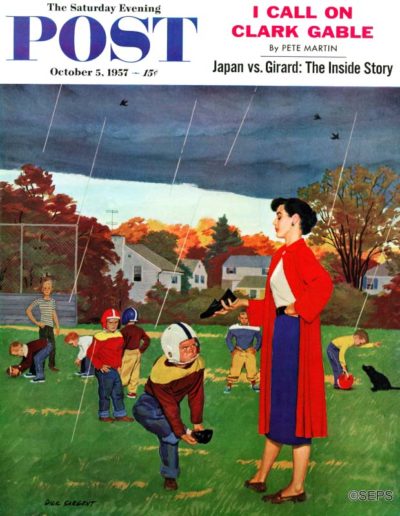
Richard Sargent
October 5, 1957
[From the editors of the October 5, 1957 issue] Women can be such a handicap sometimes—“Aw, ma, halfbacks don’t wear rubbers. Next thing, you’ll want me to make touchdowns with my poncho on. Next thing, you’ll want me to run the end with an umbrella.” To which mother replies, “James, football men obey the quarterback’s signals or get benched. The bench is home. Now then, four, eleven, forty-four, hip—on rubbers!” Well, the maxim says that mothers know best, and if James catches cold by getting wet everywhere except his feet, let’s switch to the maxim that only Monday-morning quarterbacks think of everything. This might have been some action picture if Dick Sargent hadn’t rung in mother; yet let’s settle for the maxim that when it comes to painting, painters know best.
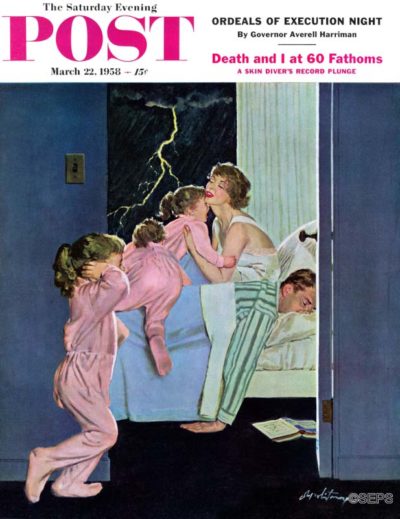
Coby Whitmore
March 22, 1958
[From the editors of the March 22, 1958 issue] Of course, the children haven’t been frightened by Papa’s snoring, but by the awful sounds of Nature on an electrical rampage. So mother will gather them in her arms and love away their fear—mustn’t it be wonderful to be a mother? If that lightning is bedeviling a far-north state, it should signify the breaking up of a winter which certainly needed breaking up; and yet not long ago some northern areas had thunderstorms followed by the blankety-blankest descent of snow for thirty-something years. Let’s leave forecasting to the weatherman, who is welcome to it. Coby Whitmore’s man of the house, buried there in the bed, must be the deepest sleeper this side of the proverbial log. How does mother get him up mornings—rap on his head with the book?
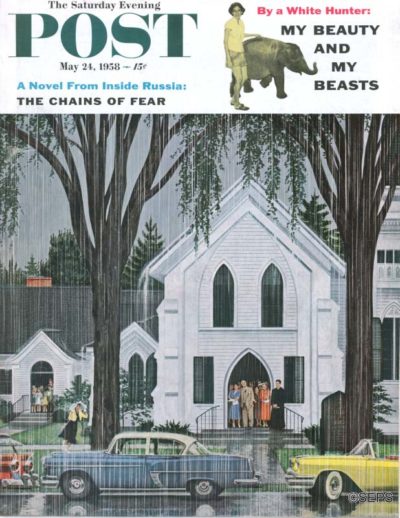
Melbourne E. Brindle
May 24, 1958
[From the editors of the May 25, 1958 issue] This wet cover had its origin in a drought. When crops withered in the Eastern states last summer, the Rev. Benjamin Axleroad, seen there at the door of St. Mark’s Episcopal Church in Bridgewater, Conn., included in his prayers a plea for precipitation. And one Sunday, just as his service ended, down came the rain, exit drought. Weeks later artist Melbourne Brindle, a St. Mark’s vestryman, puzzled some of the congregation by posing them at the church and refusing to tell them what it was all about—surprise, folks, you’re in the Post! Comments on the cover scene: (l) artistic license helped keep that grass green during the drought; (2) if any of the parishioners were out on a golf course during the deluge, how remorseful they must have been that they weren’t in church.
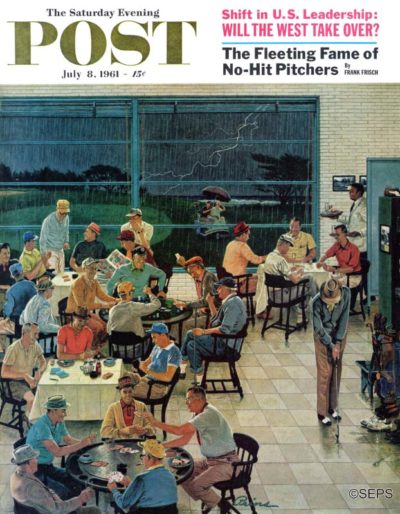
Ben Kimberly Prins
July 8, 1961
[From the editors of the July 8, 1961 issue] How do you like that? On Saturday afternoon—prime time at any golf club—comes the deluge. Well, that’s par for the course, we suppose, and the course in this Ben Prins cover belongs to The Dunes Club of Myrtle Beach, South Carolina. That wave in the background is a fringe of the Atlantic Ocean, not the crest of an oncoming flood. The three-wheeled vehicle under the umbrella is what is known as a caddy car, and its occupants are either fair-weather athletes scurrying toward the indoor recreation of the nineteenth hole, or spirited souls bent on challenging their fellow duffers to a game of motorized water polo. At any rate they’re not slowing down at the putting green. The weather being what it is, they’re probably less concerned about sinking putts than about sinking, period.